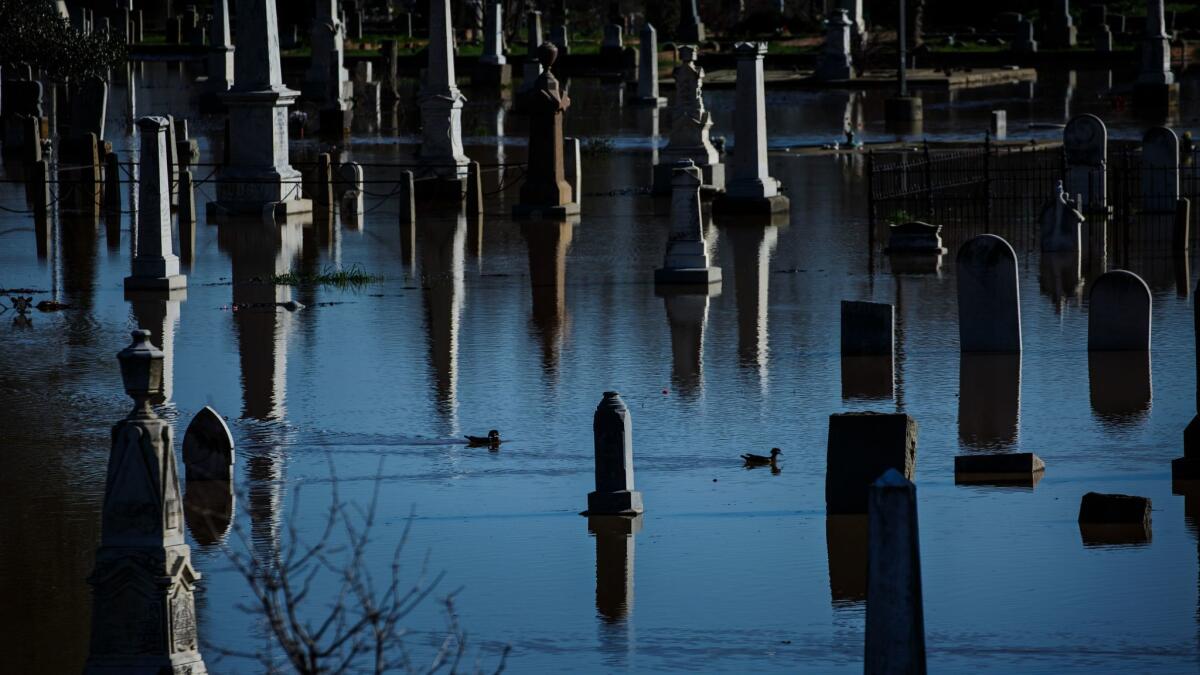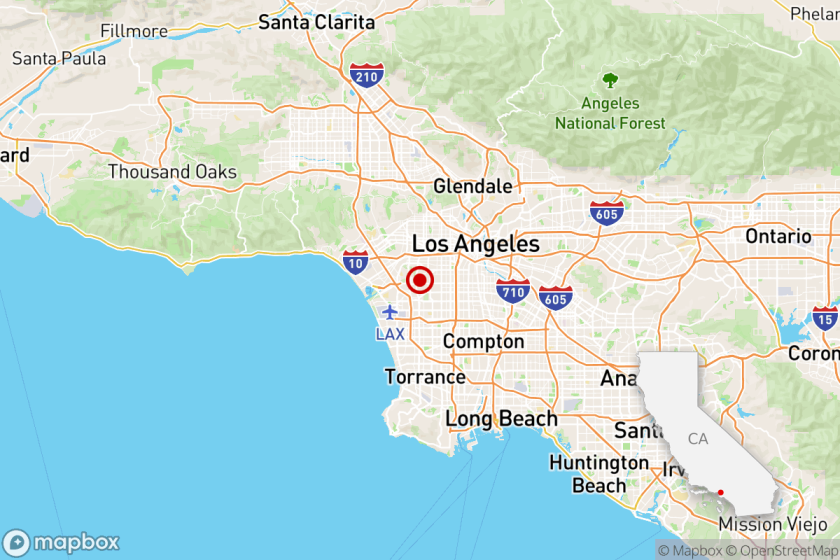Life below Oroville Dam: Stoicism, faith ... and cars poised for a fast getaway
To live beneath the Oroville Dam requires a certain measure of faith — faith in the engineers who designed the nation’s tallest dam and the construction workers who built it more than a half century ago, and faith in the government agencies that maintain and operate it.
Most often it is an unspoken faith, rarely challenged or even contemplated. The dam is simply a given, part of the landscape, like the powerful Feather River it holds back and then releases to run by the edge of town. This week was different.
Mayor Linda Dahlmeier was attending a business conference in Atlanta when she learned that the reservoir’s main spillway had begun to throw off chunks of concrete. The 59-year-old, second-term mayor called her contacts at the state Department of Water Resources, who assured her things were under control.
A few days later, when water started to wash down an earthen emergency spillway for the first time in Oroville’s history, she booked a flight home. On Sunday afternoon Dahlmeier boarded her final leg, an 80-minute flight from San Diego to Sacramento, reassured by the latest DWR pronouncements that the backup spillway was performing as designed.
“I turned my phone back on when we landed, and it just exploded,” she recalled. “In that 80 minutes, everything had changed.”
While she was in the air, a crater developed at the top of the emergency spillway, threatening to send a wall of water into Oroville and other communities downstream. Dahlmeier called a top-ranking DWR official in Sacramento.
“How could this happen?” she demanded.
‘“I’m sorry,’” she was told. ‘“But it happened, and you have to evacuate everyone in the flood plain.’”
The official’s voice “cracked,” the mayor recalled, “and my knees buckled.”
Oroville, with a population of a little more than 16,000, offers something of a municipal hodgepodge: a quaint downtown of shops and small businesses, housed in two-story brick structures that date back to the 1850s. Big-box stores, fast-food restaurants and strip malls to the south. Modest bungalows in the flats. And newer, finer homes in the hills and around the lake.
What defines it most of all is the Feather River, which flows just past downtown before hooking southwest to make its run to join the Sacramento River.
A key component of the state water project, the Oroville Dam captures water for shipment to Southern California. For those who live in its shadow, however, the dam’s main virtue — besides luring summertime boaters and campers to the lake behind it — is to protect the town, and the vast floodplain below it.
“A commodity,” Lori Price, owner of Mug Shots, a popular coffee shop downtown, calls it. Price, 58, belongs to family that has lived in Oroville for six generations, and she has seen photographs of people standing “knee deep in water” during pre-dam floods.
“We take it for granted, for doing its job,” she said of the dam. When the evacuation order came, she maintained her faith that the spillways would not fail, that the dam would hold and, in time, would be properly repaired.
“I don’t know if it’s me being naïve,” she said. “Sure, you panic, but also I just kept thinking that they need to protect that commodity at all costs. It serves the state, from here all the way down.”
Too big to fail?
“Yes,” she said.
There are two types of residents in Oroville: those who live in the flats below the dam and those who occupy neighborhoods on high ground. When the evacuation order came, those in the flats fled to shelters miles north — or reacquainted themselves with friends or family in the higher country.

After the mandatory evacuation order was lifted Tuesday afternoon, Brad Marr returned his mother to her home on Stormes Avenue near downtown. On Sunday he had taken her to his place by the lake, which provided an all-too-vivid view of the frantic efforts underway to shore up the emergency spillway — helicopters racing to drop boulders into the breach, trucks hauling more materials across the dam.
“It’s nerve-wracking watching everything that is going on, all the activities up here,” the 55-year-old car salesman said as he paused while unloading his mother’s bags. “With that much going on you wonder, maybe they are not telling you everything.”
Indeed, as the spillways eroded, so to a degree did the faith that is essential to the compact between the dam and the residents who rely on its integrity. This led to heated discussion on radio talk shows and in private conversations about deferred maintenance, overtaxed infrastructure and the like.
The crack in that faith also allowed some dark rumors to seep through. There was talk of overheard operational radio traffic of the dam beginning to make “rumbling” noises; of new, unannounced breaches; of a hydroelectric plant beneath the dam beginning to slip away into the river.
At a minimum, said Tom Kinney, a 64-year-old bus driver who has lived beneath the dam for 40 years, “you know it was built by the lowest bidder.”
Kinney had ridden his motorcycle to a neighborhood called Lemon Hill, where he joined a small knot of men who had come to watch the ongoing repair operation through their binoculars. One complained about a stand of oaks interfering with the view.
It is an Oroville curiosity: Down in the flats, the dam that looms so near is kept hidden by foothills and trees. Few homes beneath the dam afforded a good vantage point for watching the emergency play out.
An exception could be found on Long Bar Road, which runs almost to the base of the hill that formed the emergency spillway. Steve Woods, a 58-year-old wildlife biologist, was working with a shovel to clear a blocked drain line alongside the road.
Over his shoulder the white slash of water pounding down the main spillway could be seen, giving rise to mists and a steady roar. As the owner of a home so close to a now much-publicized dam, Woods’ mind was on real estate perceptions.
“Well,” he responded, when asked about the emergency’s impact, “the value of my house went down. I can’t sell my house now, unless I give it away.”
Along with his few neighbors, Woods chose to ignore the emergency order, though a flood map showed if things had gone poorly he’d be standing in water, at best.
Living near a dam or, for that matter, a river capable of flooding, requires stoicism, a nuanced understanding of the pattern and power of unleashed water, and a faith in individual instincts.
As Woods shoveled, a neighbor stopped by to compare notes. Like Woods, John Carney, a 59-year-old retired Marine and deputy sheriff, chose not to evacuate. He placed his faith in the dam.
“If the dam itself goes, I am history,” he said. “If the spillway goes, it’s going to go around me and down into town. That’s the way it is, I think. But I don’t have any data to show it.”
He did take one precaution, loading both his and his wife’s cars and pointing them toward the road for a fast escape should the spillways give way.
“We were ready to roll,” Carney said. Had the spillway begun to fail, he said, “I would have heard it. At my porch, I can hear the water coming down. If I hear a loud cracking, rumbling sound, I think I can beat it out.”
With a chuckle, he envisioned himself racing up the street, shooting video with his phone as the water chased him.
“That’s my plan, anyway,” he said. “If it doesn’t work, at least my kids will have something to talk about for the rest of their lives.”
Lead photo caption: California Water Service district manager Toni Ruggle surveys the Feather River at Bedrock Park downstream from Oroville Dam. (Brian van der Brug / Los Angeles Times)
Twitter: @peterhking
Start your day right
Sign up for Essential California for news, features and recommendations from the L.A. Times and beyond in your inbox six days a week.
You may occasionally receive promotional content from the Los Angeles Times.




